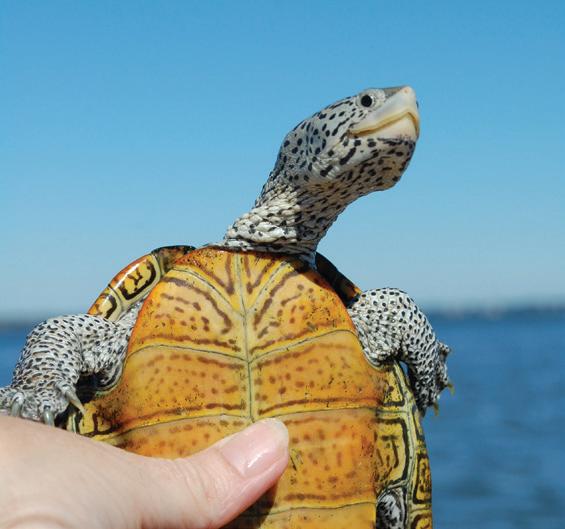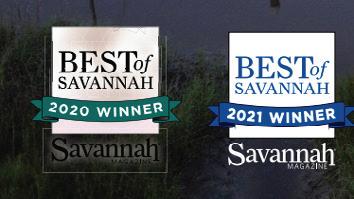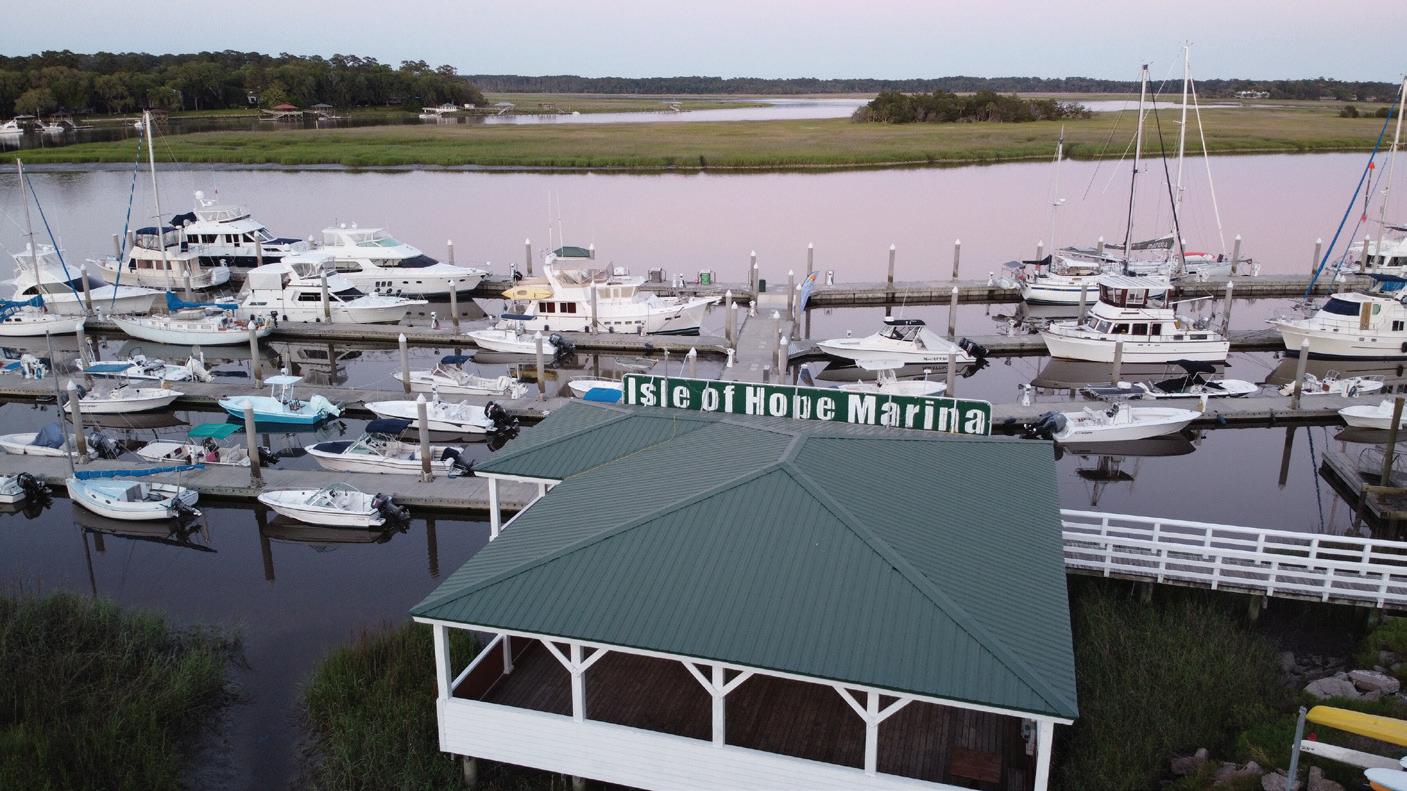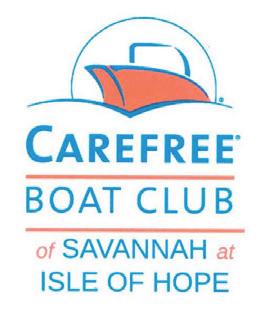
5 minute read
The Bitter End
Terrapin what?
By Captain J. Gary "Gator" Hill
Advertisement
"Hey Grandpa, what's for dinner?"
Some of you may remember that question posed to Grandpa Jones on the classic hit Hee Haw. Usually, the reply was some colorful country classic cuisine from possum to squirrel or anything in between. But long before then, the answer could have been Terrapin soup. This month our sea turtles return to our beaches, and we will be looking for turtle nests – not to raid them for their eggs, but rather to protect them from any that would seek to devour them.
While our majestic sea turtles always seem to garner much of the limelight and love, there is another little feller that gets overlooked so often today: yep, the terrapin, or more precisely the diamondback terrapin, dweller of saltwater marshes and brackish backwaters. This shy little guy is the only turtle that calls the saltwater marsh home. Many years ago, this turtle was on everyone’s lips, quite literally.
The name terrapin comes partially from the Algonquin, Abenaki and the Delaware languages mean good tasting, and in the 1800s terrapins were considered a daily staple for some, and a delicacy for others.
First Nations Peoples found the terrapin an abundant food source, and later those enslaved from Africa were give these turtles as part of their daily fair because they were plentiful and cheap. Later, by the time of Andrew Jackson’s presidency, they were starting to show up on the plates of Washington’s elite.
I remember reading somewhere long ago that Secretary of State William Seward (Lincoln’s administration) ate terrapin soup every day for lunch. (It seemed he had quite the exotic appetite and often hosted parties with as many as seventeen courses.) Even companies like Heinz and Campbells jumped on the bandwagon and sold canned terrapin soups nationwide.
Sadly, by the early 1900s this creature was pushed to the brink of extinction. What had been purchased for just a few dollars a dozen had skyrocketed to a hundred dollars or more for a single turtle.
Though eating terrapins was far from unique, many other turtles have found their way from the rivers and woods to human’s dinner tables. From the snapping turtles of my mountain home to green sea turtles which are still being eaten in the Cayman Islands, though they are grown and harvested in breeding farms.
Fortunately, many turtle species, including our seas turtles, have been protected since 1973 with the Endangered Species
A diamondback terrapin snagged in a net, prior to being released. Photo by Amy Thurman
Act. However, prior to that, the only thing that slowed down the terrapin soup craze (aside from astronomical pricing) was Prohibition. Yep, that’s right. Why, you might ask? It seems that one of the main ingredients needed to make an awesome turtle bisque is booze, either sherry or Madeira. No alcohol, no soup.
Although our diamondback terrapins have grown in numbers since being removed from the menu, they’re still considered vulnerable. Humans continue to impact this species through diminished habitat and encroachment on their breeding grounds, and another danger is from crab traps. Traps that have been abandoned in the water, have been lost, or cut away from their buoys, and even those still actively used for crabbing, as the same food that attracts crabs also attracts our other shelled friends, namely turtles and terrapins.
When I was a paddle guide, I would collect abandoned and cast-off traps and clear them out of my areas. When fish or other creatures get caught in them and die, the traps are essentially baited, enticing terrapins and other sea life to become trapped and suffocate. I have literally dumped 10 or more dead turtles from a single trap.
This sea turtle season let’s pay special attention to, and try to protect, all of our shelled friends. If you see obviously abandoned crab traps (no buoy, embedded in mud, rusted or with growth) please remove and dispose of them. Crabbers, please pull your traps before storms to avoid them being lost.
'Til our wakes cross again, peace and love, and shrimp and grits. I'll see you on the water!
Create Your Own Sustainable Garden
The Food Not Lawns movement contends that growing sustainable, edible plants is better for the environment than a manicured lawn is. Many people across the country are embracing this idea. If you want to plant a garden at your house, what do you need to know to get started? Let’s take a closer look.
Food Not Lawns movement
Food Not Lawns is a grassroots movement designed to show homeowners how to grow sustainable gardens using permaculture techniques. The idea is that purely decorative lawns are not habitable for birds and bees, which make up an essential part of our ecosystem.
Choosing the right plants
The right plants for your new garden will depend on where you live because your location affects the number of seasons you get and the amount of sun you get each day. Many people choose edible gardens and plant easy-to-grow vegetables such as tomatoes and cucumbers.
Educating your family
The best part about planting a garden instead of a lawn is that it can be a family activity. Maintaining a lawn is about mowing and fertilizing, which are solo activities. But planting, maintaining and harvesting a garden can be done by the whole family.
Harvesting your garden
Speaking of the harvest, if you’ve chosen to grow fruits and vegetables in your garden, you can expect great rewards. For example, you can get strawberries in the early summer, pick tomatoes all summer long and find many squash varieties ready in the fall.

6349 Abercorn Street Savannah, GA 912.352.1222 • MyCBHomes.com Lyn McCuen 912.224.0927
lyn@coldwellbanker.com www.lynmccuen.com


Complimentary High-Speed Wi-Fi 30-50-100 amp electrical service 4,000 feet of floating concrete docks 600 feet of deepwater face docks
Introducing marker 46a
Introducing our new addition, Marker 46A, exclusively for Isle of Hope Marina guests! Featuring an outdoor deck with comfortable seating and picturesque water views. Inside, you can find complimentary coffee, WiFi, high definition TV, and ceiling fans. Complimentary loaner cars and bicycles Ship ' s Store and Laundry Facilities 2,000 sq ft overwater pavilion Private restrooms and showers Gas, Diesel, and Pump-out facilities



Scan to learn more about the Carefree Boat Club










